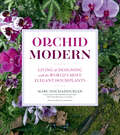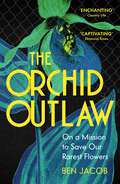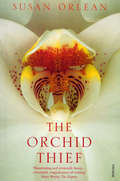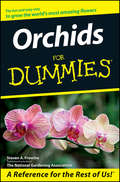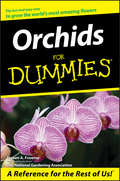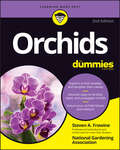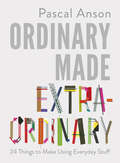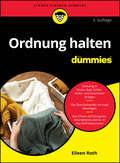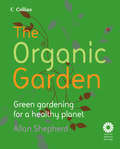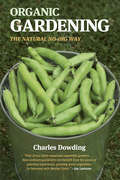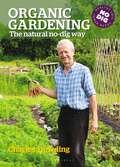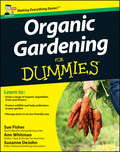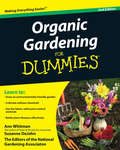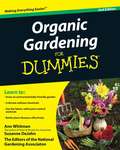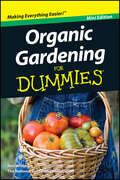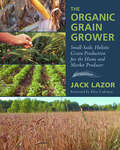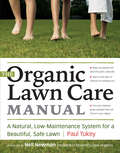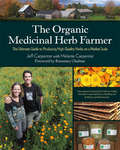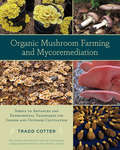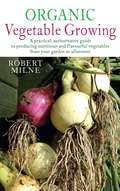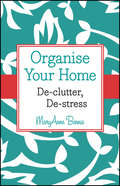- Table View
- List View
Orchid Modern: Living and Designing with the World's Most Elegant Houseplants
by Marc HachadourianOrchid expert Marc Hachadourian makes it easier than ever to successfully grow, design, and craft with orchids.
The Orchid Outlaw: On a Mission to Save Britain's Rarest Flowers
by Ben JacobTEN YEARS AGO, BEN JACOB TURNED OUTLAW TO SAVE OUR RAREST FLOWERS. THIS IS HIS STORY.Obsessed by orchids since childhood, Ben spent years travelling to far-flung jungles to see them in the wild. Then a chance encounter set him off on a journey of discovery into the wonderful, but often forgotten, world of Britain's fifty-one native species. These include the Bee which looks (and smells) so much like one that even bees are fooled, the Ghost which exists without sunlight, and Autumn Lady's Tresses which gave Darwin the proof he needed for his theory of evolution.But our orchids are in desperate trouble. Many species are facing extinction. Decimated by changes in land use and climate, inadequately protected by environmental and planning laws, their habitats are disappearing fast. Determined to act before it was too late, Ben broke into building sites in the dead of night to rescue threatened plants, and turned his kitchen into a laboratory, his fridge into storage for hundreds of baby orchids, and his back yard into a plantation. But doing all that put him on the wrong side of the law. . . At once a memoir, a natural history, and an inspiring call to action, reintroducing us to Britain's most endangered flowers, The Orchid Outlaw shows us how we can all save the world, one plant at a time.
The Orchid Thief: A True Story Of Beauty And Obsession
by Susan OrleanSusan Orlean first met John Laroche when visiting Florida to write for the New Yorker about his arrest for stealing rare ghost orchids from a nature reserve. Fascinated both by Laroche and the world she uncovered of orchid collectors and growers, she stayed on, to write this magical exploration of obsession and the strange world both of the orchid obsessives and of Florida, that haunting and weird 'debatable land' of swamps and condos, retirement communities and real-estate scams. The world of the orchid hunters, breeders and showmen, their rivalries, vendettas and crimes, smuggling, thefts and worse provide the backdrop to a fascinating exploration of one of the byways of human nature, the obsessive world of the collector, and the haunting beauty of the flowers themselves.
Orchids For Dummies
by Steven A. Frowine National Gardening AssociationPacked with photos, including 8 pages in full color Color your world with orchids Orchids are beautiful, fragrant, wonderfully varied, and surprisingly affordable. But aren't they hard to grow at home? No! says orchid grower extraordinaire Steve Frowine. In this handy guide, he shows you step by step how to select the right orchids, keep them healthy, encourage blooms, and even propagate your own plants. Discover how to: * Select orchids that will thrive in your home * Water, fertilize, repot, and propagate orchids * Decipher complicated orchid names * Get familiar with favorite orchid varieties * Create spectacular orchid displays
Orchids For Dummies
by Steven A. Frowine National Gardening AssociationPacked with photos, including 8 pages in full color Color your world with orchids Orchids are beautiful, fragrant, wonderfully varied, and surprisingly affordable. But aren't they hard to grow at home? No! says orchid grower extraordinaire Steve Frowine. In this handy guide, he shows you step by step how to select the right orchids, keep them healthy, encourage blooms, and even propagate your own plants. Discover how to: * Select orchids that will thrive in your home * Water, fertilize, repot, and propagate orchids * Decipher complicated orchid names * Get familiar with favorite orchid varieties * Create spectacular orchid displays
Orchids For Dummies
by Steven A. Frowine National Gardening AssociationBecome a plant parent to some of the most stunning flowering plants you’ve ever seen Orchids display more beautiful and exotic flowers than you’ll find on other flowering plants, but they do require some love and care to grow well. With help from Orchids For Dummies, anyone can be successful in growing and flowering these gorgeous and fragrant plants in their garden or home! This step-by-step guide shows you how to select orchids that will thrive in your own unique environment and how to water, fertilize, repot, and propagate them on your own. You’ll learn to decipher complicated orchid names (“phalaenopsis,” anyone?) and create spectacular displays. You’ll also discover: New information about updated plant and orchid classification systems so you can know what to buy at your local garden center or store Expanded info on moth orchids, one of the most popular varieties of the plant sold in the world today Updated instructions on which pesticides, fertilizers, and potting materials you should be using Perfect for amateur gardeners, orchid-lovers, and anyone interested in growing these exquisite flowers on their own, Orchids For Dummies will turn your thumb green in no time at all!
Orchids For Dummies
by Steven A. Frowine National Gardening AssociationBecome a plant parent to some of the most stunning flowering plants you’ve ever seen Orchids display more beautiful and exotic flowers than you’ll find on other flowering plants, but they do require some love and care to grow well. With help from Orchids For Dummies, anyone can be successful in growing and flowering these gorgeous and fragrant plants in their garden or home! This step-by-step guide shows you how to select orchids that will thrive in your own unique environment and how to water, fertilize, repot, and propagate them on your own. You’ll learn to decipher complicated orchid names (“phalaenopsis,” anyone?) and create spectacular displays. You’ll also discover: New information about updated plant and orchid classification systems so you can know what to buy at your local garden center or store Expanded info on moth orchids, one of the most popular varieties of the plant sold in the world today Updated instructions on which pesticides, fertilizers, and potting materials you should be using Perfect for amateur gardeners, orchid-lovers, and anyone interested in growing these exquisite flowers on their own, Orchids For Dummies will turn your thumb green in no time at all!
Ordinary Made Extraordinary
by Pascal Anson'Filled with inexpensive and relatively easy do-it-yourself design projects for the home. Step-by-step photos show you how to do everything from dipping vintage cutlery in paint and reupholstering an armchair in shoelaces to covering a wall in mirrors' - Telegraph 'True original Pascal Anson urges us, with winning wit and idiot-proof step-by-steps to turn ''dad'' jeans, an ugly table, holey trainers, mismatched cutlery [...] into desirable stuff using the alchemy of imagination. His brief? Low skill levels and high concept' - World of Interiors In Ordinary Made Extraordinary designer, artist and maverick-maker Pascal Anson shows how easy it is to transform everyday items into extraordinary statement pieces. Make ordinary a thing of the past with 24 inspiring and achievable projects including: - Create a chandelier with just a few rolls of Sellotape. - Cast a stunning concrete plant pot. - Build a child’s treehouse with cling film.There are ideas for projects for everyone – from repairing and reinventing worn out trainers, to bigger projects such as the wood-clad car and the stylish hairy chair.
Ordnung halten für Dummies (Für Dummies)
by Eileen RothDamit Tohuwabohu ein Fremdwort bleibt Haben Sie es satt, ewig Ihren Schlüssel zu suchen und ihn später im Kühlschrank wiederzufinden? Ordnung halten: Dem einen ist es einfach gegeben, die anderen müssen es mühsam lernen. Eileen Roth zeigt Ihnen, wie Sie Ihr Zuhause ordentlich halten und Ihren Arbeitsplatz effizient gestalten. Außerdem erfahren Sie, wie Sie Ihre Daten auf Computer, Smartphone und Co. ordnen und Ihren Urlaub so planen, dass Sie richtig entspannen. Wenn Sie gut organisiert sind, haben Sie weniger Arbeit, weniger Stress, mehr Freizeit und mehr Entspannung. Mithilfe dieses Buches finden Sie immer, was Sie suchen Sie erfahren Welche Hilfsmittel Ihnen beim Ordnen helfen Was Sie aufheben sollten und was nicht Welche grundlegenden Techniken es für das Zeitmanagement gibt Wie Sie das Chaos mit System beseitigen
The Organic Garden: Green And Easy
by Allan ShepherdThe Organic Garden redefines what it means to be an organic gardener. This practical and thought-provoking handbook is both a manual of organic practice and a starting point for ethical living.
Organic Gardening: The Natural No-Dig Way
by Charles DowdingCharles Dowding, who started the first vegetable box scheme in 1983, shares the philosophy, tips and techniques which have enabled him to run a successful organic garden supplying local restaurants and shops for over 25 years.
Organic Gardening: The natural no-dig way
by Charles DowdingThe UK's leading no-dig gardening expert, Charles Dowding, shares his organic approach to growing healthy, vibrant crops.The no-dig approach to gardening – based on the key principle of leaving the ground as undisturbed as possible – has gained popularity in recent years as a more efficient, economical and sustainable way to grow healthy plants.Packed with easy-to-follow advice, Organic Gardening reveals the art of the no-dig approach and the techniques required to grow organic crops while enhancing soil structure.By employing the simplicity of the no-dig technique and using a system of permanent, slightly raised beds, Charles Dowding shows how to grow a delicious variety of fruit and vegetables sustainably and organically: what to choose; when to sow, plant and harvest; and how best to avoid pests and diseases.From sowing seeds and making compost to harvesting summer salads and winter vegetables, this accessible guide is an essential resource for beginners and experienced gardeners.
Organic Gardening for Dummies (For Dummies)
by Sue FisherReduce a garden's impact on both the environment and the wallet Organic Gardening For Dummies shows readers the way to ensure a healthy harvest from an environmentally friendly garden. It covers information on the newest and safest natural fertilizers and pest control methods, composting, cultivation without chemicals, and how to battle plant diseases. It also has information on updated equipment and resources. It helps the reader to plant organically year-round, using herbs, fruits, vegetables, lawn care, trees and shrubs, and flowers. Organic Gardening For Dummies show readers how to: Plan out the perfect organic garden Protect wildlife and help pollinators in a garden Grow a range of organic vegetables, fruits and flowers Manage pests in an eco-friendly way
Organic Gardening for Dummies
by Sue FisherReduce a garden's impact on both the environment and the wallet Organic Gardening For Dummies shows readers the way to ensure a healthy harvest from an environmentally friendly garden. It covers information on the newest and safest natural fertilizers and pest control methods, composting, cultivation without chemicals, and how to battle plant diseases. It also has information on updated equipment and resources. It helps the reader to plant organically year-round, using herbs, fruits, vegetables, lawn care, trees and shrubs, and flowers. Organic Gardening For Dummies show readers how to: Plan out the perfect organic garden Protect wildlife and help pollinators in a garden Grow a range of organic vegetables, fruits and flowers Manage pests in an eco-friendly way
Organic Gardening For Dummies
by Ann Whitman Suzanne DeJohn The National Gardening AssociationOrganic Gardening For Dummies, 2nd Edition shows readers the way to ensure a healthy harvest from their environmentally friendly garden. It covers information on the newest and safest natural fertilizers and pest control methods, composting, cultivation without chemicals, and how to battle plant diseases. It also has information on updated equipment and resources. It helps readers plant organically year-round, using herbs, fruits, vegetables, lawn care, trees and shrubs, and flowers. The tips and techniques included in Organic Gardening For Dummies, 2nd Edition are intended to reduce a garden's impact on both the environment and the wallet.
Organic Gardening For Dummies
by Ann Whitman Suzanne DeJohn The National Gardening AssociationOrganic Gardening For Dummies, 2nd Edition shows readers the way to ensure a healthy harvest from their environmentally friendly garden. It covers information on the newest and safest natural fertilizers and pest control methods, composting, cultivation without chemicals, and how to battle plant diseases. It also has information on updated equipment and resources. It helps readers plant organically year-round, using herbs, fruits, vegetables, lawn care, trees and shrubs, and flowers. The tips and techniques included in Organic Gardening For Dummies, 2nd Edition are intended to reduce a garden's impact on both the environment and the wallet.
Organic Gardening For Dummies, Mini Edition (For Dummies Ser.)
by Ann Whitman National Gardening AssociationNo synopsis available.
The Organic Grain Grower: Small-Scale, Holistic Grain Production for the Home and Market Producer
by Jack LazorThe ultimate guide to growing organic grains on a small and ecological scale, The Organic Grain Grower is invaluable for both home-scale and commercial producers interested in expanding their resiliency and crop diversity through growing their own grains. Longtime farmer and organic pioneer Jack Lazor covers how to grow and store wheat, barley, oats, corn, dry beans, soybeans, pulse crops, oilseeds, grasses, nutrient-dense forages, and lesser-known cereals. In addition to detailed cultivation and processing information, Lazor argues the importance of integrating grains on the organic farm (not to mention for the local-food system) for reasons of biodiversity and whole farm management. Including extensive information on: The history of grain growing and consumption in North America The twenty-first century and the birth of the local-food movement Considering your farm's scale and climate Understanding soil fertility and structure Planting your crop (including spring vs. fall cereals and preparing your soil) The growing and ripening process (reproductive, milk, hard-and-soft dough stages) The grain harvest Preparing grain for sale, storage, or end use (drying, cleaning seed, grain handling) Seed breeding and saving Machinery, infrastructure, and processing (both home-scale tools and larger farm equipment) Grinding grains for livestock rations (including how to put together a ration based on protein content) and sample rations for dairy cows, pigs, and chickens Processing grains for human consumption Additional resources and information for new grain farmers, and more... Beginners will learn how to grow enough wheat for a year's supply of bread flour for their homestead, and farmers will learn how to become part of a grain co-op, working alongside artisan bakers and mills. Never before has there been a guide to growing organic grains applicable both for the home-scale and professional farming scale. This will be a classic for decades to come and a crucial addition to any farmer's, homesteader's, gardener's, agronomist's, or seed-saver's library.
The Organic Lawn Care Manual: A Natural, Low-Maintenance System for a Beautiful, Safe Lawn
by Paul TukeyCreate a gorgeous lawn that is free of harsh chemicals. This comprehensive guide covers everything you need to know to grow and maintain a thriving lawn using organic gardening methods. With expert advice on planting the best grass varieties, nourishing the soil, watering, fighting weeds, and sustainable maintenance, Paul Tukey helps you create a luscious and inviting lawn that is pesticide-free and safe for your children and pets.
The Organic Medicinal Herb Farmer: The Ultimate Guide to Producing High-Quality Herbs on a Market Scale
by Jeff Carpenter Melanie Carpenter Rosemary GladstarA new approach to growing local medicine, including information on geo-authenticity, wildcrafting, and developing a good business plan Both a business guide and a farming manual, The Organic Medicinal Herb Farmer will teach readers how to successfully grow and market organic medicinal Western herbs. Whether you’re trying to farm medicinal plants, culinary herbs, or at-risk native herbs exclusively or simply add herbal crops to what you’re already growing, successful small-scale herb farmers Jeff and Melanie Carpenter will guide you through the entire process—from cultivation to creating value-added products. Using their Zack Woods Herb Farm in Vermont as a backdrop, the Carpenters cover all the basic practical information farmers need to know to get an organic herb farm up and running, including: • Size and scale considerations; • Layout and design of the farm and facilities; • Growing and cultivation information, including types of tools; • Field and bed prep; • Plant propagation; • Weed control, and pests and diseases; • Harvesting, as well as wild harvesting and the concept of geo-authentic botanicals; • Postharvest processing; and, • Value-added products and marketing. The authors also provide fifty detailed plant profiles, going deeper into the herbs every farmer should consider growing. In an easy-to-understand, practical, and comprehensive manner, readers will learn how to focus on quality over quantity, and keep costs down by innovating with existing equipment, rather than expensive technology.Market farmers who have never before considered growing medicinal herbs will learn why it’s more important to produce these herbs domestically. The Organic Medicinal Herb Farmer makes a convincing case that producing organic medicinal herbs can be a viable, profitable, farming enterprise. The Carpenters also make the case for incorporating medicinal herbs into existing operations, as it can help increase revenue in the form of value-added products, not to mention improve the ecological health of farmland by encouraging biodiversity as a path toward greater soil health.
Organic Mushroom Farming and Mycoremediation: Simple to Advanced and Experimental Techniques for Indoor and Outdoor Cultivation
by Tradd CotterWhat would it take to grow mushrooms in space? How can mushroom cultivation help us manage, or at least make use of, invasive species such as kudzu and water hyacinth and thereby reduce dependence on herbicides? Is it possible to develop a low-cost and easy-to-implement mushroom-growing kit that would provide high-quality edible protein and bioremediation in the wake of a natural disaster? How can we advance our understanding of morel cultivation so that growers stand a better chance of success? For more than twenty years, mycology expert Tradd Cotter has been pondering these questions and conducting trials in search of the answers. In Organic Mushroom Farming and Mycoremediation, Cotter not only offers readers an in-depth exploration of best organic mushroom cultivation practices; he shares the results of his groundbreaking research and offers myriad ways to apply your cultivation skills and further incorporate mushrooms into your life—whether your goal is to help your community clean up industrial pollution or simply to settle down at the end of the day with a cold Reishi-infused homebrew ale. The book first guides readers through an in-depth exploration of indoor and outdoor cultivation. Covered skills range from integrating wood-chip beds spawned with king stropharia into your garden and building a “trenched raft” of hardwood logs plugged with shiitake spawn to producing oysters indoors on spent coffee grounds in a 4×4 space or on pasteurized sawdust in vertical plastic columns. For those who aspire to the self-sufficiency gained by generating and expanding spawn rather than purchasing it, Cotter offers in-depth coverage of lab techniques, including low-cost alternatives that make use of existing infrastructure and materials. Cotter also reports his groundbreaking research cultivating morels both indoors and out, “training” mycelium to respond to specific contaminants, and perpetuating spawn on cardboard without the use of electricity. Readers will discover information on making tinctures, powders, and mushroom-infused honey; making an antibacterial mushroom cutting board; and growing mushrooms on your old denim jeans. Geared toward readers who want to grow mushrooms without the use of pesticides, Cotter takes “organic” one step further by introducing an entirely new way of thinking—one that looks at the potential to grow mushrooms on just about anything, just about anywhere, and by anyone.
Organic Vegetable Growing: The Complete Guide to Growing Nutritious and Tasty Vegetables the Organic Way
by Robert MilneGrowing your own organic vegetables will give you fresher, tastier and more nutritious produce with no food miles, fossil fuel use or packaging; and will provide you with the simple but enormous pleasure and satisfaction of supplying at least part of your own food requirements. This authoritative book provides detailed, practical guidance for those who wish to make the most of their time and whatever area of ground is available to grow vegetables the organic way. It looks forward to productive gardening becoming increasingly relevant and necessary as we are obliged to adapt to global trends, including climate change and diminishing oil resources that will adversely affect food production. The techniques described are applicable to any scale of gardening and are based on the author's thirty years of organic gardening experience, including twenty years of self-sufficiency and eight as a professional gardener growing vegetables and fruit in walled gardens.
Organise Your Home: De-clutter, De-stress
by MaryAnne BennieIs your clutter taking control of your life? Organise Your Home will show you how to use the in8steps system and organise your entire home without turning it into total chaos in the process. Work at a pace your lifestyle allows and use this tried-and-tested system to completely overhaul your relationship with your stuff. MaryAnne Bennie is an organising expert, speaker and director of in8 home office and life organising.
Organise Your Home: De-clutter, De-stress
by MaryAnne BennieIs your clutter taking control of your life? Organise Your Home will show you how to use the in8steps system and organise your entire home without turning it into total chaos in the process. Work at a pace your lifestyle allows and use this tried-and-tested system to completely overhaul your relationship with your stuff. MaryAnne Bennie is an organising expert, speaker and director of in8 home office and life organising.
